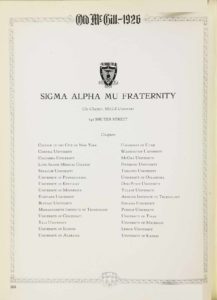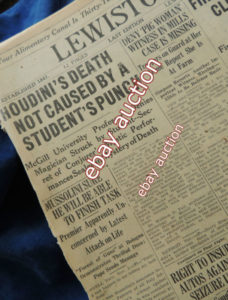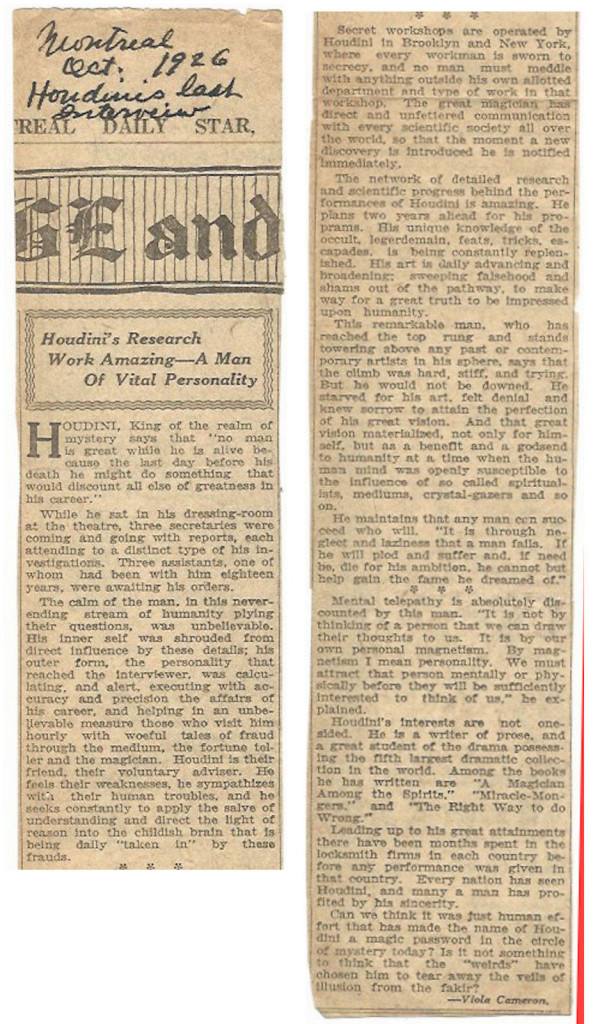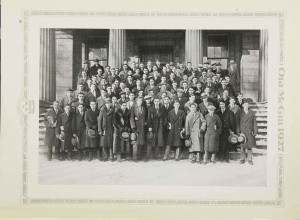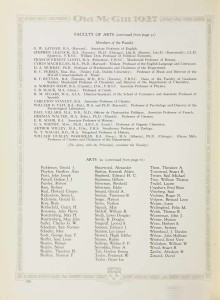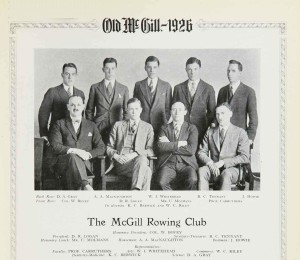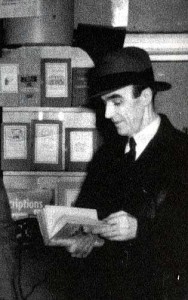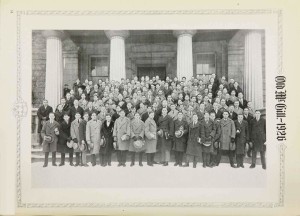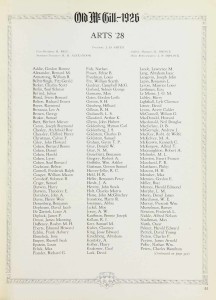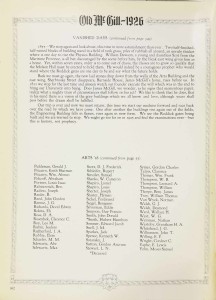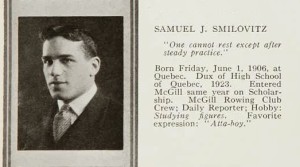
Samuel J. Smilovitz a.k.a “Smiley” was the art student who sketched Houdini during his lecture at McGill’s Union Hall on October 19, 1926. Houdini was so impressed with the sketch that he invited Smiley to come see him backstage at the Princess Theater and do another for him. Smiley invited a friend, Jacques Price, and together they visited Houdini on October 22. It was during this visit that a third student, J. Gordon Whitehead, who was unknown to both Smiley and Price, joined the gathering. The rest is Houdini history or is it.
According to Frank Koval in the Illustrated Houdini Research Diary, Houdini is struck in the stomach by Smiley on October 22nd. What?
And according to Walter B. Gibson in The Master Magicians, all three students delivered punches, which would have included Smiley. What?
During the week of October 17, 1926, Houdini appeared in Montreal, and one morning toward the end of his engagement, a group of college students [Smiley, Price, Whitehead] stopped at the theater to interview him. Houdini talked about the physical fitness needed in his escapes acts, and demonstrated how he could brace the muscles of his abdomen to offset heavy blows. One student, then another, delivered punches at Houdini’s invitation.
As a third hesitated, Houdini relaxed, thinking the youth had given up the idea. Instead, the student made a belated swing. Houdini received the punch off guard, and it nearly crumpled him, but he managed to brush it off as if had not hurt him.
That night, he complained of a pain in his side, which grew steadily worse. When the show reached Detroit, he was running a fever, but still insisted upon giving his performance when he learned that the theater was sold out. That was Houdini’s last show. He collapsed at the finish and was rushed to hospital, suffering from an acute case of appendicitis. Surgeons operated immediately, but peritonitis was so far advanced that they were unable to save the patient’s life. He died on Halloween, 1926.
All of this said, the full story of the events leading to Houdini’s death was first told, to the best of my knowledge, in a well-written, detailed article by Stanley Handman which appeared in the Canadian Weekend Picture Magazine for 12th September, 1953.
But wait a minute! Sam J. Smiley is the source of the article. It is believed that Stanley Handman gave his column that week to Smiley.
As far as I know, Smiley’s 1953 article is the first time that Whitehead’s name was first publically mentioned as the one that struck Houdini in the stomach. What?
And a letter from Ernst, Fox and Cane to Smilowitz says:
“we understand you and your friends were in Houdini’s room, and one of your friends struck the blows, and so forth, we understand it was purely accidental. Our sole interest is in collecting on a double indemnity accident insurance policy for Mrs. Houdini. Would you help by telling us what happened?”
Notice the only name they have is Smilowitz because he had given Houdini the sketch and his address. We know Jacques Price was Smiley’s friend, but what about Whitehead?
So who punched Houdini in the dressing room at the theatre? Smiley, Price, Whitehead or some other young man?
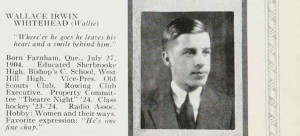
According to Silverman’s book,
[Smiley] identified the young man as Whitehead, a first-year student at McGill, and some biographers of Houdini have identified him further as J. Gordon Whitehead, but the only freshman with that surname, according to the school’s yearbook, was named Wallace (Wallie) Whitehead, a good-looking twenty-two-year-old with slicked-down hair, manager of the class hockey league.

Believed to be J. Gordon Whitehead at McGill
Since Silverman’s book, both Wallie and Gordon Whitehead have been found at McGill and they may have been brothers. What?
Whitehead, Smiley and Price were the only ones besides Houdini who knew what happened in the dressing room.
While anyone of the three students could have punched Houdini in the dressing room, the only real evidence that it was only J. Gordon Whitehead (30 years old) and not Wallace I Whitehead (22 years old), Smiley or Price is the affidavit from a J. Gordon Whitehead that has recently been made available.
According to the affidavit from J. Gordon Whitehead (3/16/1927),
I struck Houdini quite moderately and he smiled and laughingly said – “Why! Hit me.” I hesitated and he repeated – “Hit me”; I struck him a second blow slightly harder than the first, he gave not the slightest indication of any discomfort at either of the blows. Both blows were struck on the left side of his body and above the navel.
The first affidavits from Samuel Smilovitz (2/10/1927) and Jacques Price (2/14/1927) don’t mention Whitehead by name, they refer to him (“about 25 years of age“) as the Third McGill Student and first year student of McGill in Arts. Interestingly, their second affidavits (SM 4/19/1927 JP 4/16/1927) do mention his name was Whitehead. The affidavit (11/26/1926) from Houdini’s First Assistant, James Collins, mentions that Houdini was in the company with one Smilovitz and two other students (no names given) of McGill University, Montreal…On such occasion one of the said students struck Houdini with two blows in his stomach merely for the purpose of showing his resistance to blows. Other affidavits from Sophie Rosenblatt (2/15/1927), Julia Karchere (5/7/1927), Julia Sauer (5/7/1927) mention that Houdini stated he had been violently struck a number of times by a student (no name given) of McGill University.
Based on the evidence, I think it is obvious, who punched Houdini?




